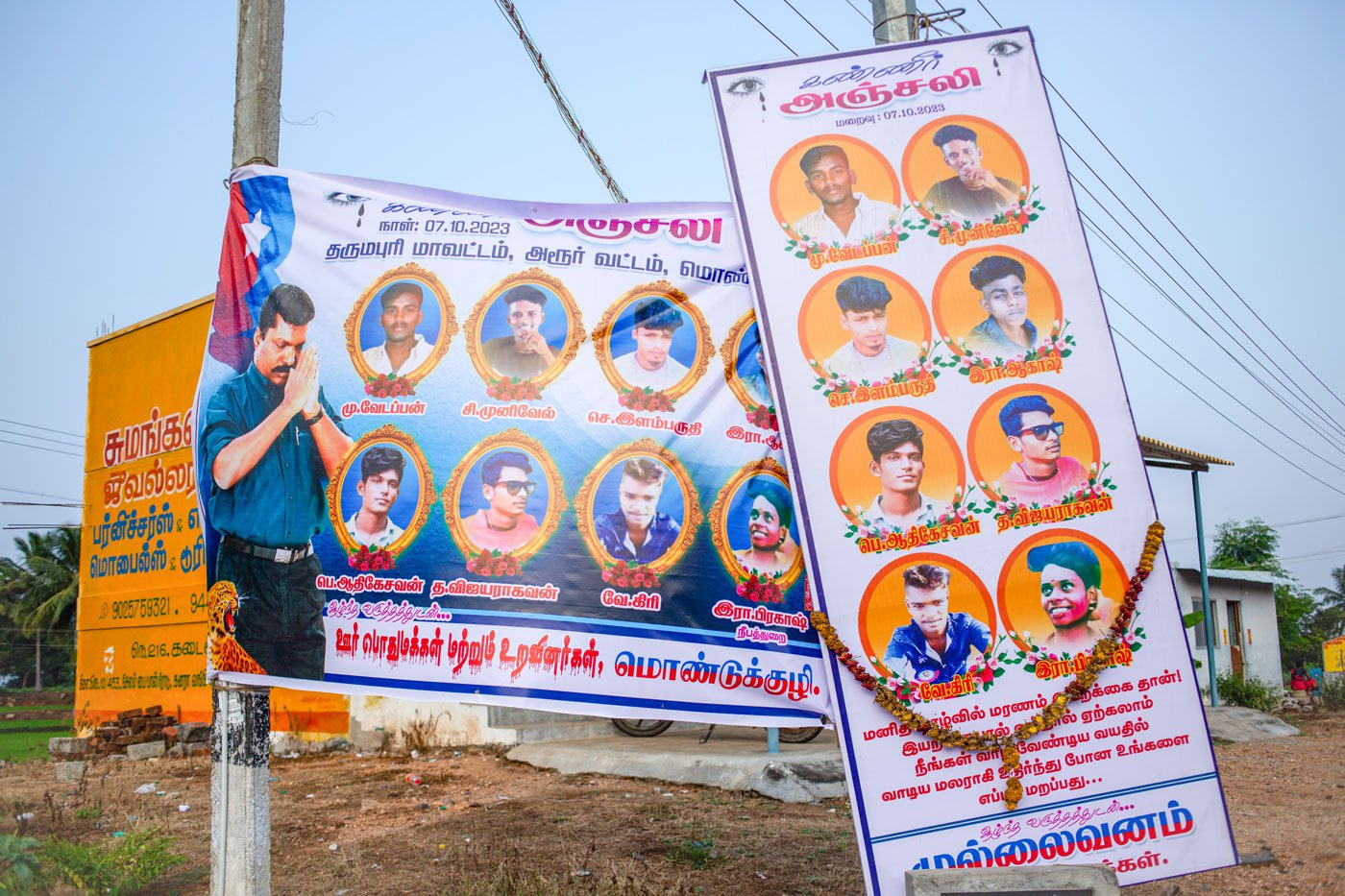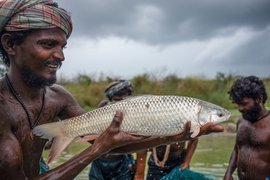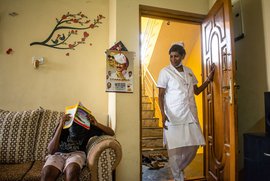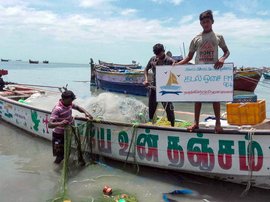I am tired. My body and mind are heavy. My eyes are filled with the pain of deaths – deaths of the oppressed around me. I am not able to write the many stories I have worked on. I feel numb. Even as I begin to write this story, the government is demolishing the houses of Dalits in Anagaputhur, Chennai. I am further paralysed.
I still cannot distance myself from the deaths of the workers in godowns holding firecrackers, in Hosur, Tamil Nadu on October 7, 2023. I have documented 22 deaths till now. Of these, eight were students between the ages of 17 and 21 years. All of them worked in godowns which held fireworks. All the eight students were from the same town and close friends.
From the time I started learning photography, I have been curious about the people who work in firework factories, godowns and shops. I tried for long yet I couldn’t get the required permissions. Through all my enquiries, I was told that the godowns will never give permission. It was not easy to get in, forget taking photographs.
My parents never bought us new clothes or crackers for Diwali. They couldn’t afford them. It was my paternal uncle – my father’s eldest brother who bought us new clothes. We would always go to our uncle’s place to celebrate Diwali. He would also buy us crackers and all the children, including my uncle’s, would burst them.
I was not too interested in bursting crackers. As I grew up, I completely stopped bursting them. I had also stopped celebrating festivals, including Diwali. Only after I ventured into photography, I began to understand about the lives of the proletariat.
I learnt a lot of things through photography.
Every year during Diwali, there were fires and accidents at cracker godowns. I
was in a place where I didn’t care much about such accidents.

The eight children killed in an explosion in a firecracker shop belonged to Ammapettai village in Dharmapuri district. A week after the deaths, the village is silent and no one is celebrating Diwali
However, this year [2023], I thought I should at least document the accidents. That's when I heard that eight children from one village were killed in a cracker explosion near Krishnagiri, on the border between Tamil Nadu and Karnataka. I learnt this from social media, just as I learn about many happenings from Instagram and Facebook. I come to know about protests too from social media.
That is how I received this news too. When I enquired with some comrades, they said that all the deceased were from the same town and had gone for work during the Diwali season. That deeply affected me. Because we too are people who go for seasonal jobs. During Vinayakar Chathurthi, we used to make garlands from Arugampul [scutch grass] and erukkam pul [milkweed] and sell them. During the marriage season, we used to work in wedding kitchens serving food. I am also a boy who used to do seasonal jobs owing to my family’s [financial] situation.
A boy, just like me, had gone for a seasonal job but had met with an accident and died. This greatly affected me.
I definitely had to document this. I started with Ammapettai at Aamur taluk in Dharmapuri district of Tamil Nadu. This village is on the banks of the Thenpannai river which flows between Dharmapuri and Thiruvannamalai. Cross the river and you are at Thiruvannamalai.
I had to take three buses to reach the village. I spent the entire time on the bus talking to comrades who knew about the situation. A comrade from Amur put me on a bus to Ammapettai promising that more comrades will be waiting for me at the bus stand. When the bus entered Ammapettai, the first thing that I saw was the statue of Ambedkar in a cage, enveloped in huge silence. The village too was silent. It was like the silence of the graveyard. It spread through my body and made me tremble. There was no noise from any house – it was as if every place was surrounded by darkness.
I didn’t feel like eating anything since I left for this assignment. I had tea and two vadas at a tea shop in front of the Ambedkar statue and waited for the comrade to arrive.
The comrade arrived and took me to the first house which had lost a son. The house had asbestos sheets on the roof; only one side was plastered.

V. Giri was 17 years old when he passed away. The youngest son, he took up work because he didn't get admission in college for a paramedical course as his marks were not high enough
We kept knocking at the locked door for several minutes before a woman came. It appeared like she had not slept for several days. The comrade said she was V. Selvi, 37, mother of V. Giri, a 17-year-old who had died in the blast. I regretted waking her up.
As we stepped into the house we saw a garlanded photo of a boy in uniform hanging from the unplastered wall. I felt like I was seeing my brother.
Soon after lockdown, my own brother had gone to do seasonal work at a cracker shop. All my pleas to not go fell on deaf ears. My mother was constantly worried about him till he came back.
Giri’s mother couldn’t speak. The moment I asked her about her son, she sat down in the corner of the house and started to cry. The comrade said we could wait for the brother of the victim. Giri’s second eldest brother arrived and started narrating the story of the death of his younger brother.
“My name is Suriya, I am 20 years old. My father’s name is Vediyappan. It has been eight years since our father died of a heart attack.”
After he spoke, their mother spoke with hesitation, in a broken voice. “Life was difficult after his death,” she said. “My eldest son finished his Class 12 and decided to go out of town to find work and send money. We started repaying our loans, and his brothers were growing up. We thought of getting him married and it has been only three months since his marriage. I managed to get the children educated under such difficult circumstances, I didn’t expect this to happen.
“Only because he couldn’t go to college for a year, he went to a textile shop for two months and he was at home for two months. He went to the cracker shop because his friends were going. And then this happened.”


Left: A photo from Giri's childhood placed within his late father Vediyappan's photo. Right: His mother, V. Selvi couldn't speak. She sat in the corner of the house and started to cry when I asked her about Giri
“During this season, thambi [younger brother] would only go to work in textile shops. This year he decided to go for this job [firecracker shop]. He had cleared his Class 12 examinations and had applied for paramedical course. His application was rejected because of low marks. Then he started going for work in textile shops. Once during aadi [seasonal month between mid-July to mid-August where textile shops have special sales and discounts], he earned 25,000 [rupees]. He used 20,000 of it to settle a family loan.
“After our father died eight years ago, we would both go to textile shops, and with the money we earned, return and clear our loans. Our elder brother got married and, in the process, we incurred a loan of 30,000 rupees.
“So, we did all kinds of jobs. For many of us, if things did not go well, we would come back home. The owner of the cracker shop spoke to one of the boys in our locality and said there were jobs at the shop. A batch left first. My brother went in the second batch.
“But there were issues among the boys who went for work, so my brother, Giri, came back and stayed with our elder brother. He was with him at work, and then my elder brother came here to visit the temple.
“It was at that time that my younger brother received a call again from the boys at cracker shop who asked him to come back to work. My brother went to work on October 7, 2023. It was the day the accident took place.
He had worked for only one day.
My brother was born on October 3, 2006. We had just celebrated his birthday. On the Oct 7 this happened.
None of us [back in the village] knew what had
happened. Two boys from the village who survived the accident informed us. We
then started enquiring and realised that seven children from our village had
died. We hired a car and went to identify the body.

The photograph of another deceased, 19-year-old Akash, is garlanded and placed on a chair in front of the house. His father, M. Raja (right)
A case was filed. Karnataka’s Chief Minister, Minister K P Anbazhagan, an MLA, MP and many more came. The collected handed over a cheque for three lakh rupees. They said the Tamil Nadu Chief Minister would come but he didn’t.
Our demand is that each family should be given a government job, according to their educational levels.”
Giri’s family said that it hoped that one of the remaining two sons will be given a government job. “Ours is an hand-to-mouth existence. It would help if one of them gets a government job.”
I asked for Giri’s photo after his mother finished talking. The brother pointed to a photo announcing his father’s death. On the corner of a frame, Giri as a child was standing in a small picture. It was a beautiful photograph.
“If only we had something like SIPCOT in Karur, our boys wouldn’t be going so far for work. Last time, the boys were brainwashed. They were told they will get a new phone when they come back. Nobody knew that the crackers had burst in the godown. All the eight boys died of asphyxiation. We checked and realised that the pathway was too small for them to come out together too. This is the first time the boys were working for a cracker shop,” said comrade Bala.
When comrade Bala said so, I was reminded of my own brother Bala. The place turned grimmer. I felt suffocated, my heart felt numb.
The families of all the eight deceased had
framed the pictures of their loved ones. Every house was like a graveyard.
People kept coming and going. It has been over a week since the accident took
place but the pain and tears remained. The relatives have stuck around.


'This is the first time he was going to this kind of job,' says Akash's father. A photo of Akash's mother (right) who passed away 12 years ago
![Raja says Akash was particularly fond of Dr. B.R. Ambedkar. 'He had hung his [Ambedkar’s] portrait [near his bed] so that he would be the first image to see when he woke up'](/media/images/07-PAL_9250-PK-Every_house_is_like_a_grave.max-1400x1120_Ou8b82x.jpg)
Raja says Akash was particularly fond of Dr. B.R. Ambedkar. 'He had hung his [Ambedkar’s] portrait [near his bed] so that he would be the first image to see when he woke up'
The photograph of another deceased, 19-year-old Akash, was garlanded and placed on a chair in front of the house. His father was lying in front of the photograph. Their house had only two rooms. When I went to their house, I could see the photograph of Akash’s mother in another photograph on another chair.
When I started talking to Akash’s father, he was crying uncontrollably. He was also under the influence of the alcohol. The comrade who took me there calmed him down and made him speak.
“I am M. Raja, 47. I wash glasses in a tea shop. My son went to the cracker shop only because his friends had gone there. He was a good boy; intelligent too. When he left for work, he gave me Rs 200 and advised me against drinking. He said he will be back in 10 days and will take care of me. This is the first time he was going to this kind of job. I have never asked him to go to work.”
Raja says how Akash was particularly fond of
Ambedkar. “He had hung his [Ambedkar’s] portrait so that he would be the first
image to see when he woke up. I was just thinking how our children have begun
to come up in life. And this happened to my own son. He went to a textile
shop for work initially. I was not even aware that he was going to cracker shop
this time. He discontinued his college after two years, but we never wanted him
to work. I work in a tea shop for 400 rupees a day. I have a daughter and two
sons. I live only for my children. It has been 12 years since my wife
died.”

Vedappan at 21 years old was the oldest of the young boys to die in the explosion. He was married just 21 days before his death
Next we visited the house of 21-year-old Vedappan. A photo of him in a coat suit next to the picture of Ambedkar was hanging on the wall, informing us of his death. He is the only one among the eight deceased who was married. It's only been 21 days since he got married. Nobody was in a position to talk except his father. Vedappan’s wife was yet to recover from the shock.
“We belong to T. Ammapatti village in Dharmapuri district. Ours is not a well-to-do family. At least seven people have gone from our village and 10 from our district. They had gone for these jobs only because of lack of employment. They had been working for barely two or three days when this happened.
“Neither the Karnataka nor the Tamil Nadu government has announced the reason for this accident. It has been difficult to even procure the death certificate. The Tamil Nadu government should give us death certificate, compensation and offer a government job based on educational qualification for each family.”


Left: A photo of Kesavan (pink shirt) with his mother, Krishnaveni and elder brother. Right: His mother didn't know he was working in the cracker shop when he died in the explosion


Left: Kumari's son Munivel was 20 years old when he died in the explosion. His photo, like all the other deceased, is displayed outside their home. Right: Illumparidhi's parents, Bhanu and Senthilkumar stand near their son's photo
Krishnaveni is the mother of R. Kesavan. In her thirties, she says she was not aware that her son had gone to work in a cracker shop. “He had gone along with his friends. We have heard nothing from the government so far but hope they will give us a job.”
Thirty five-year-old Kumari who lost her son to the accident speaks about the selfies shared by her son on the day of the accident. “They go to such dangerous jobs only because they want to provide for us during Diwali. So that they could get new clothes or gifts. They earn 1,200 rupees in a cracker shop, while in a textile shop they earn only 700-800 rupees.
“Imagine how I felt to see the selfies of them having lunch and immediately after that to see their bodies?
No family should suffer the way ours did. There should be no accident in
cracker shops. Even if there is one, there should be some way for those in the
shop to escape. If that is not happening, the shop shouldn’t be allowed to
function. Let our family be the last one to suffer such a loss,” says
Kumari.


Left: A photo of T. Vijayaraghavan, Kesavan and Akash that they sent to their families by Whatsapp shortly before the accident took place. Their charred bodies (right) were unrecognisable


Saritha shows a photo of Vijayaraghavan on her phone. She says all the memories of her son are in the photos in her phone
When we visited 18-year-old T. Vijayaraghavan’s house, his mother was very unwell and had gone to the hospital. When she came back, I could see how tired she was. She still spoke to us but only after we drank the buttermilk offered to us by Vijayaraghavan’s sister.
“He told me that he was going to a textile shop. I am not sure why he went to a cracker shop. I know he wanted to pay fees for college and didn’t want to burden us because we were spending all we had on our daughter’s health. We would be grateful if the government gives us some job” says 55-year-old Saritha.
Along with a few comrades and Vijayaraghavan’s father, we visited the place where the eight boys were cremated. “They were already burnt beyond recognition. We cremated them together” Vijayaraghavan’s father said.
The Thenpannai river flowed still, bearing witness to the cremation of eight young lives that had once held promise and love for the future.
I returned. My heart was numb.
Two days later, I woke up to the news of 14 people dying in Sivakasi – a major centre for firecracker manufacture.

All the eight boys were cremated together

The Thenpannai river that flows between Dharmapuri and Thiruvannamalai districts of Tamil Nadu



